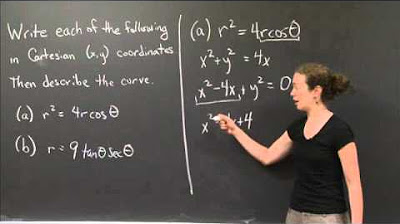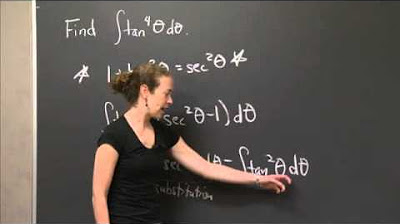Verifying a trigonometric Identities
TLDRThe video script presents a mathematical proof that aims to verify the equation: 1 + (sin(theta)/cos(theta)) + (cos(theta)/(1 + sin(theta))) = 2*sec(theta). The presenter begins by acknowledging the complexity of the equation and the initial disbelief that both sides could be equivalent. The solution process involves finding a common denominator for the fractions, which leads to a perfect square on one side. Using trigonometric identities, particularly the Pythagorean identity sin^2(theta) + cos^2(theta) = 1, the equation is simplified step by step. Eventually, the presenter demonstrates that the left side of the equation simplifies to 2*sec(theta), confirming that the initial equation holds true. The video serves as a tutorial on applying trigonometric identities and algebraic manipulation to prove a trigonometric statement.
Takeaways
- 🧮 The problem involves verifying an equation that initially seems complex, but simplifies through trigonometric identities and operations.
- 📐 The equation presented is 1 + (sin(theta) / cos(theta)) + (cos(theta) / (1 + sin(theta))) = 2*sec(theta).
- 🔍 The speaker chooses to work with the more complicated side of the equation to simplify it, applying operations to both sides to find a common denominator.
- 🤔 The common denominator between cos(theta) and 1 + sin(theta) is found by multiplying the two denominators together.
- 📈 After finding a common denominator, the equation is expanded to include a perfect square trinomial, which includes terms with sine and cosine of theta.
- ✅ Utilizing the Pythagorean identity sin^2(theta) + cos^2(theta) = 1, the equation is further simplified.
- 🔑 Factoring out a 2 from the numerator allows the equation to be simplified to 2 + 2*sin(theta) over the common denominator.
- 🧐 The terms in the numerator are then divided by the denominator, leaving 2*sec(theta), which matches the right side of the original equation.
- 📉 The final step is to confirm that the simplified left side of the equation is indeed equal to the right side, thus verifying the original equation.
- 🎓 The process demonstrates the importance of understanding trigonometric identities and applying algebraic operations to simplify and verify trigonometric equations.
- 📚 The video script serves as a tutorial for students on how to approach and solve complex trigonometric equations through step-by-step simplification.
Q & A
What is the initial expression given in the transcript?
-The initial expression is 1 + (sine of theta) / (cosine of theta) + (cosine of theta) / (1 + sine of theta) which is said to be equal to 2 secant of theta.
Why does the speaker believe that the two expressions might not look the same at first glance?
-The speaker believes they might not look the same because the initial expression has sines and cosines, and it seems complex, making it hard to see how it could simplify to 2 secant of theta.
What is the first step the speaker takes to simplify the expression?
-The first step is to find a common denominator for the fractions involving sine and cosine of theta, which leads to multiplying by the denominator on both sides of the equation.
What trigonometric identity does the speaker use to further simplify the expression?
-The speaker uses the Pythagorean identity, which states that sine squared theta plus cosine squared theta equals 1, to simplify the expression.
How does the speaker approach the problem of simplifying the expression with sine and cosine terms?
-The speaker decides to convert the cosine terms to secants, and then uses the Pythagorean identity to eliminate the sine terms, eventually aiming to get the expression in terms of secant of theta.
What is the final simplified form of the expression that the speaker arrives at?
-The final simplified form is 2 secant of theta, which matches the right side of the original equation, thus verifying the initial claim.
Why is it important to have a common denominator when adding fractions in trigonometry?
-Having a common denominator is important because it allows you to combine the fractions into a single fraction, making it easier to perform operations and simplify the expression.
What does the speaker mean by 'apply operations' in the context of simplifying the expression?
-By 'apply operations,' the speaker refers to the process of performing mathematical operations (like addition, subtraction, multiplication, and division) to simplify the expression and make it easier to work with.
How does the speaker use the concept of a perfect square to help simplify the expression?
-The speaker identifies that multiplying the binomial (1 + sine of theta) by itself results in a perfect square trinomial, which can then be expanded and simplified using the Pythagorean identity.
What is the significance of factoring out a 2 from the expression?
-Factoring out a 2 from the expression helps to isolate terms and simplify the fraction, eventually leading to the cancellation of terms and the emergence of the secant term in the denominator.
Why does the speaker emphasize the importance of simplifying the expression?
-Simplifying the expression is crucial for verifying the equation and for making it easier to see the underlying mathematical relationships and patterns, which in this case, leads to the verification of the initial claim.
What is the role of the Pythagorean identity in this problem?
-The Pythagorean identity (sine squared theta + cosine squared theta = 1) is used to combine and simplify the terms involving sine and cosine, which is a key step in transforming the left side of the equation into the form of 2 secant of theta.
Outlines
🧮 Simplifying Trigonometric Expressions
The speaker begins by presenting the expression 1 + sin(θ)/cos(θ) and aims to verify that it is equivalent to 2 sec(θ). They acknowledge the initial skepticism about the equivalence and decide to simplify the more complex side of the equation first. The speaker discusses the limitations of applying trigonometric identities at this stage and suggests converting cosines to secants. They then decide to apply operations by adding a common denominator, which leads to multiplying both sides by the denominators. The resulting expression is a perfect square, which the speaker leaves undistributed to facilitate further simplification.
🔍 Applying Trigonometric Identities
The speaker now has a common denominator and can combine like terms, resulting in an expression involving sine and cosine squared. They apply the Pythagorean identity, which states that sine squared plus cosine squared equals 1, to simplify the expression further. The speaker then factors out a 2 to isolate the 1 + sin(θ) term in the denominator. They emphasize the need to keep cosine in the denominator to eventually obtain secant, and by dividing out common terms, they are left with 2/cos(θ), which can be written as 2 sec(θ). The speaker confirms that the left side of the original equation is indeed equivalent to the right side, thus verifying the equation.
Mindmap
Keywords
💡Trigonometric identities
💡Common denominators
💡Pythagorean identities
💡Secant
💡Simplification
💡Verify
💡Multiply across
💡Distribute
💡Combine like terms
💡Factor out
Highlights
The transcript discusses verifying the equality between a trigonometric expression and 2 secant of theta.
The initial impression is that the two expressions are not the same, which prompts a closer examination.
The approach involves simplifying the more complex side of the equation using trigonometric identities.
The transcript emphasizes the importance of finding a common denominator to combine terms.
A perfect square trinomial is formed by multiplying the two denominators across each other.
The Pythagorean identity (sine squared plus cosine squared equals 1) is applied to simplify the expression.
The process involves combining like terms after applying the Pythagorean identity.
The transcript demonstrates factoring out a common factor to simplify the expression further.
The final simplified form of the expression is shown to be equivalent to 2 secant of theta.
The verification of the equation is completed by comparing the simplified expression to the original equation.
The transcript provides a step-by-step guide to applying operations and trigonometric identities in a complex equation.
The importance of converting cosines to secants to match the form of the equation is discussed.
The process of simplifying fractions and finding a common denominator is emphasized for clarity and ease of calculation.
The transcript illustrates the application of planar operations in the context of trigonometric equations.
The use of the distributive property to combine terms with a common denominator is explained.
The transcript concludes with the successful verification of the initial equation, showcasing the power of trigonometric identities.
The entire process is a practical application of trigonometric identities and algebraic manipulation in verifying equations.
Transcripts
Browse More Related Video

Trig limit using pythagorean identity | Limits and continuity | AP Calculus AB | Khan Academy

Polar to Cartesian | MIT 18.01SC Single Variable Calculus, Fall 2010

Integrals: Trig Substitution 2

Integral of tan^4 (theta) | MIT 18.01SC Single Variable Calculus, Fall 2010

Ex 2: Simplify Trigonometric Expressions

Rectangular Equation to Polar Equations, Precalculus, Examples and Practice Problems
5.0 / 5 (0 votes)
Thanks for rating: